🧪 CBSE Class 9 Science Chapter 11 – Sound (ध्वनि) English & Hindi 📝 By Grandmaster Bikram Sutradhar (SirBikramSutradhar) | BASTRONAUTWAY

🧪 CBSE Class 9 Science Chapter 11 – Sound (ध्वनि) English & Hindi 📝 By Grandmaster Bikram Sutradhar (SirBikramSutradhar) | BASTRONAUTWAY
📘 Chapter Overview – English
Let’s explore the fascinating topic of “Sound” with this comprehensive bilingual guide crafted by Grandmaster Bikram Sutradhar (SirBikramSutradhar), exclusively for the BASTRONAUTWAY program.
This chapter explains how sound is created, how it travels through various substances, and how it reflects and behaves. Core concepts like frequency, amplitude, wavelength, echo, SONAR, and the ear’s mechanism are explained in simple bilingual points to help learners understand quickly and score better in exams.
📘 अध्याय सारांश – हिंदी
यह अध्याय Grandmaster Bikram Sutradhar (SirBikramSutradhar) द्वारा BASTRONAUTWAY पहल के अंतर्गत तैयार किया गया है, जिसमें ध्वनि से जुड़ी सभी आवश्यक अवधारणाओं को सरल दो-भाषीय प्रारूप में समझाया गया है।
इसमें आप जानेंगे कि ध्वनि कैसे उत्पन्न होती है, माध्यमों में कैसे यात्रा करती है, और इसकी परावर्तन, प्रतिध्वनि, सोनार एवं मानव कान की कार्यप्रणाली क्या होती है।
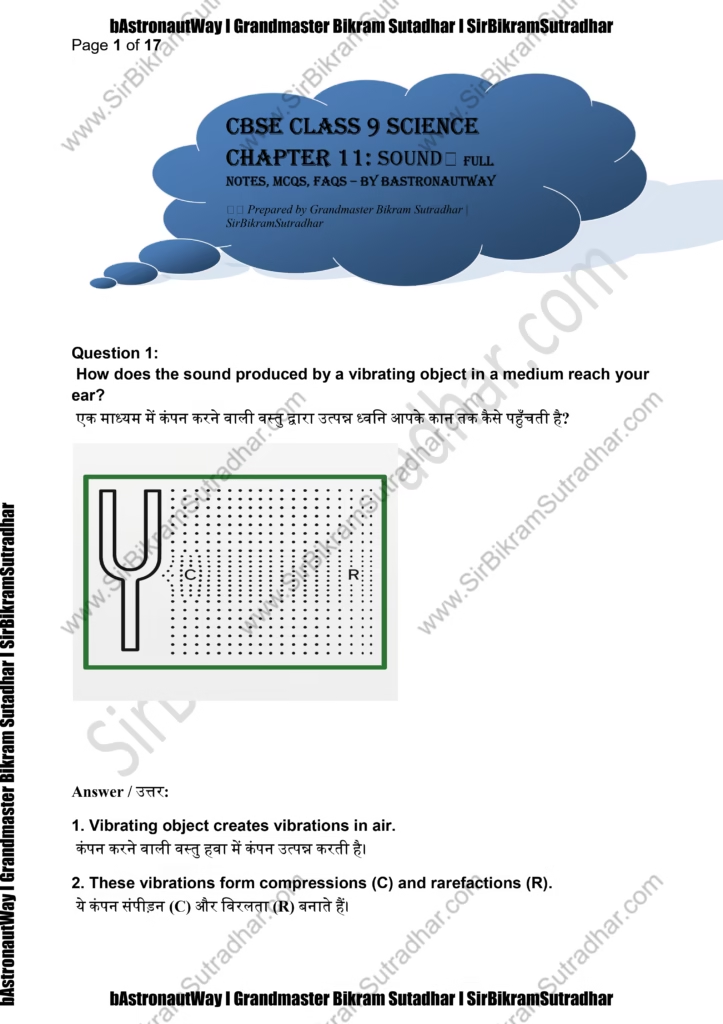
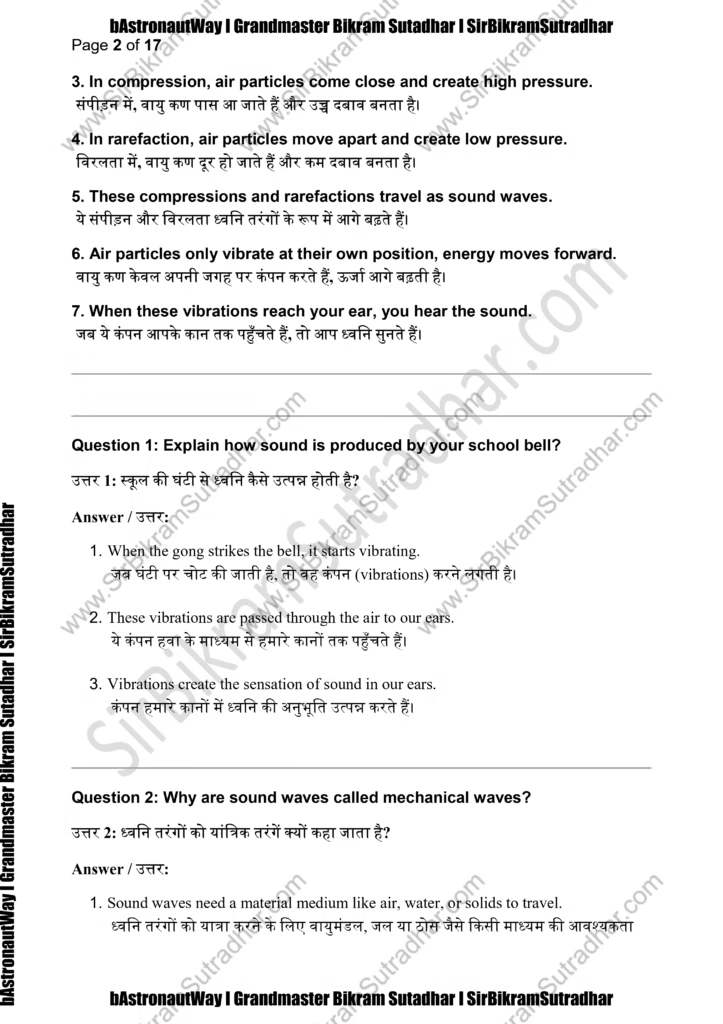




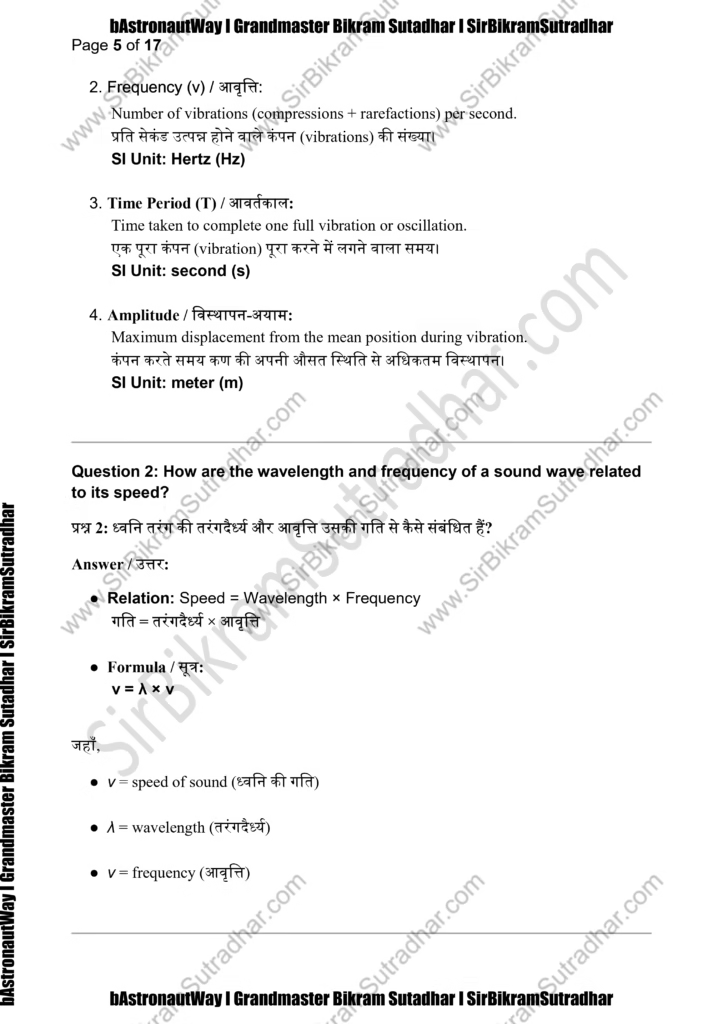
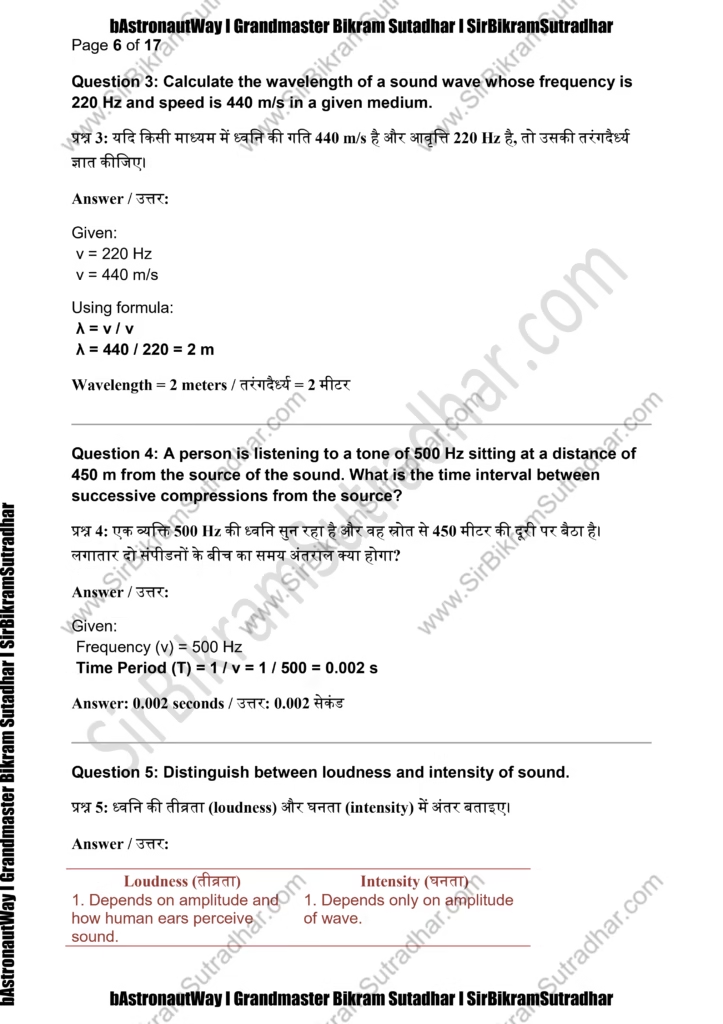
📒 Detailed Notes – English + Hindi
🔹 1. Definition of ध्वनि की परिभाषा
• Sound is a form of mechanical energy that enables hearing.
ध्वनि एक यांत्रिक ऊर्जा है जो हमें सुनने की क्षमता देती है।
🔹 2. Source of ध्वनि का स्रोत
• Whenever an object vibrates, it produces sound.
🎵 Examples / उदाहरण: Guitar strings, vocal cords, tuning fork
गिटार की तारें, स्वररज्जु, ट्यूनिंग फोर्क
🔹 3. How Sound Travels / ध्वनि कैसे फैलती है
• Sound travels in the form of longitudinal waves and cannot move through vacuum.
ध्वनि अनुदैर्ध्य तरंगों के रूप में फैलती है और निर्वात में नहीं चल सकती।
🌬 Mediums / माध्यम: Air (वायु), Water (जल), Solids (ठोस)
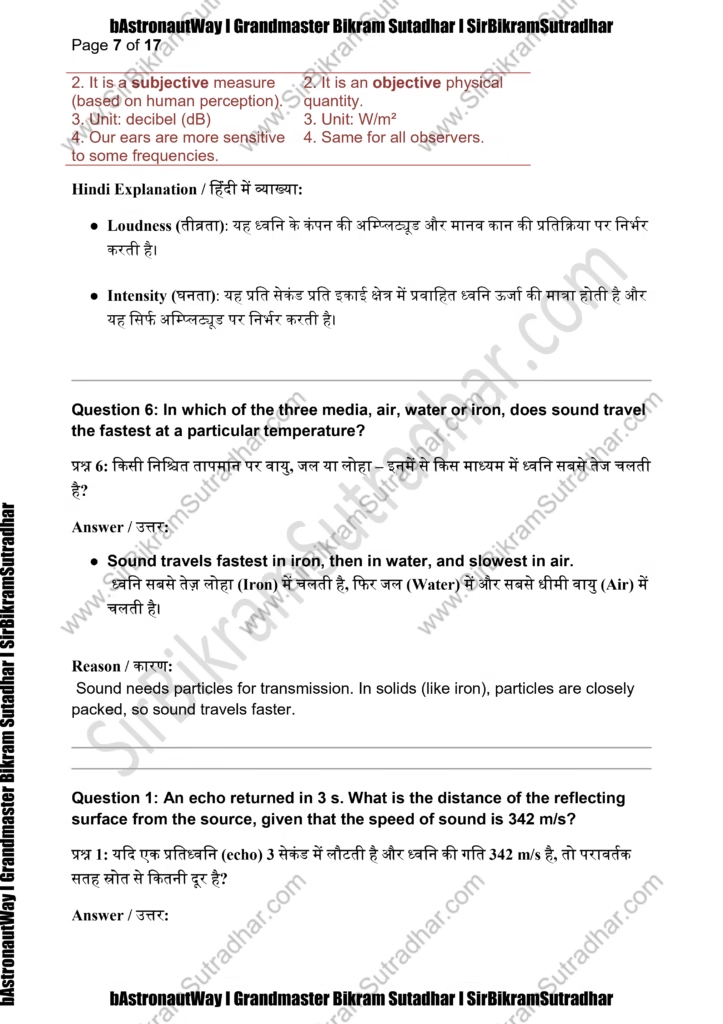

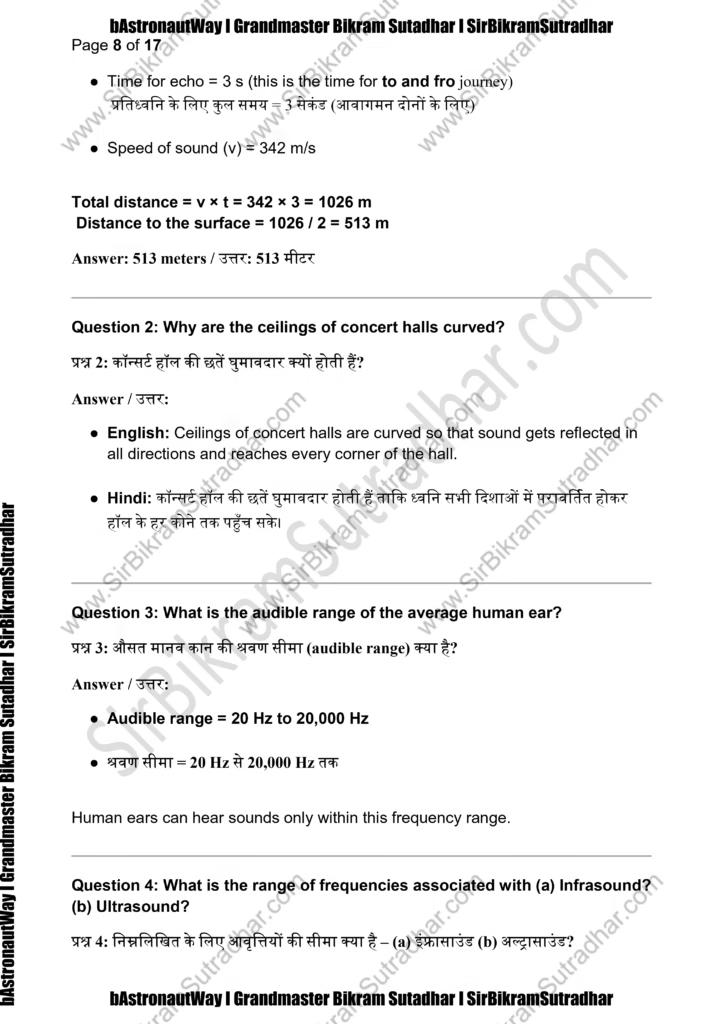

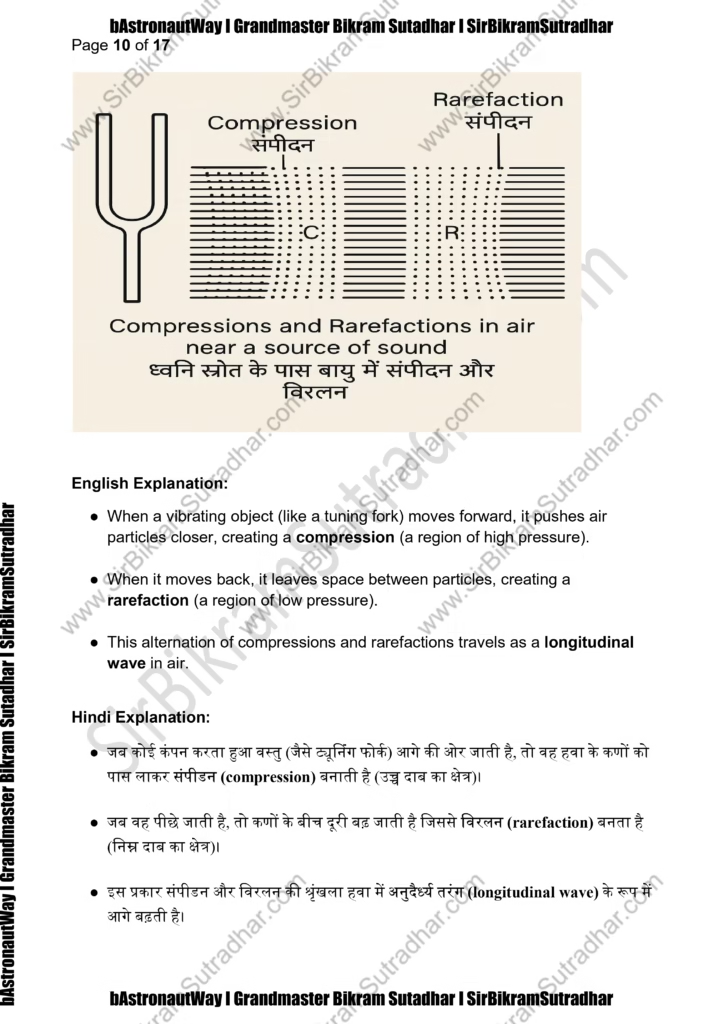
🔹 4. Features of Sound Waves / ध्वनि तरंगों की विशेषताएँ
| Property | English Meaning | हिंदी अर्थ |
| Frequency | Number of vibrations per second (Hz) | प्रति सेकंड कंपन की संख्या (Hz) |
| Amplitude | Height of wave, shows loudness | तरंग की ऊँचाई, तीव्रता दर्शाती है |
| Time Period | Time taken for one vibration cycle | एक पूर्ण कंपन में लगने वाला समय |
| Wavelength | Distance between two compressions | दो संपीड़नों के बीच की दूरी |

📌 Sound speed in different mediums / विभिन्न माध्यमों में ध्वनि की गति:
- Air (वायु): 343 m/s
- Water (जल): 1482 m/s
- Iron (लोहा): 5960 m/s
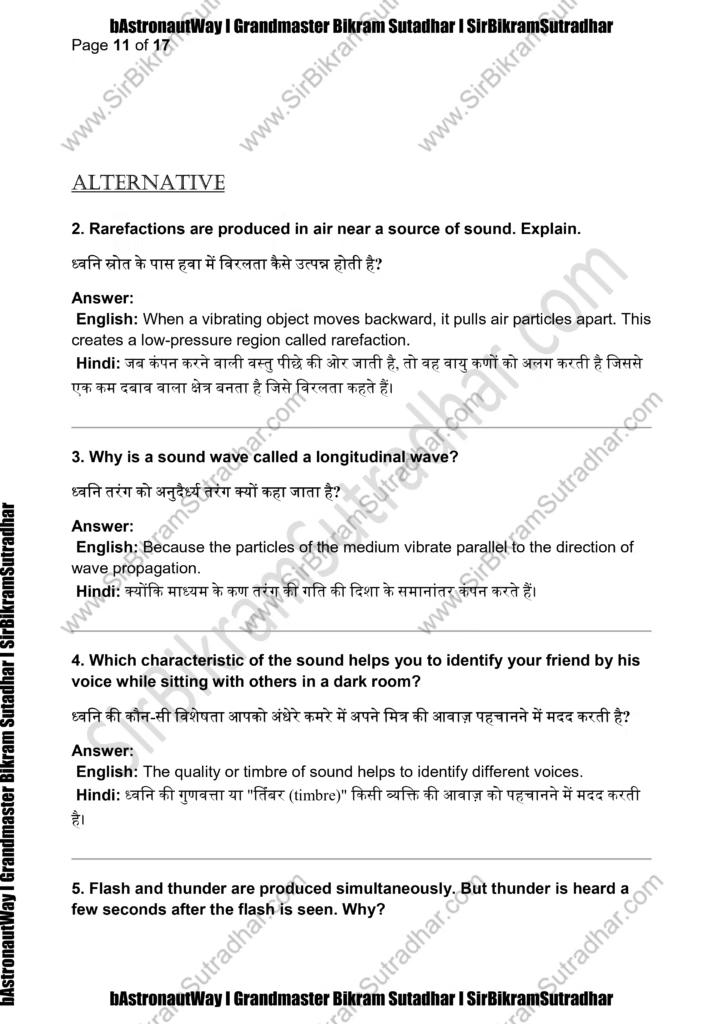

-
📘 Becoming an Astronaut in India (ISRO) – A Complete Guide After Class 12
📘 Becoming an Astronaut in India (ISRO) – A Complete Guide After Class 12 ✍️…
-
📘 Calculus: GATE Engineering Mathematics – Section 2
📘 Calculus: GATE Engineering Mathematics – Section 2 🧠 Prepared with Inspiration from GrandMaster Bikram…
-
✍️ Master English Grammar: Fun Tricks & Smart Hacks for Confident English! 📚✨
✍️ Master English Grammar: Fun Tricks & Smart Hacks for Confident English! 📚✨ 🔥 Presented…
-
Germany’s Warm Admiration for Indian & Asian Communities
🇩🇪✨ Germany’s Warm Admiration for Indian & Asian Communities A Heartfelt Celebration of Culture, Talent,…
-
📘 Master Vedic Math: Multiply Big Numbers Fast (3×3 & 4×4 Digit Trick)
📘 Master Vedic Math: Multiply Big Numbers Fast (3×3 & 4×4 Digit Trick) 👨🏫 By…
-
📘 Vedic Math: Multiplication & Division Shortcut Tricks
📘 Vedic Math: Multiplication & Division Shortcut Tricks 👨🏫 By Grandmaster Bikram Sutradhar🏆 5× World…
-
📘 VEDIC MATH: SQUARE & CUBE TRICKS (Full Guide for Competitive Exams)
📘 VEDIC MATH: SQUARE & CUBE TRICKS (Full Guide for Competitive Exams) 👨🏫 By Grandmaster…
-
📅Calendar Tricks & Shortcuts – Learn to Find Day, Date & More in Seconds!
📅 Calendar Tricks & Shortcuts – Learn to Find Day, Date & More in Seconds!…
-
🔥 Ultimate Guide to Computer & Laptop Shortcut Keys 🧠💻
🔥 Ultimate Guide to Computer & Laptop Shortcut Keys 🧠💻 🚀 Boost your speed 10X…
-
July 2025 Vedic Moon‑Sign Horoscope 🌙 | Saturn & Mercury Retrograde Insights
July 2025 Vedic Moon‑Sign Horoscope 🌙 | Saturn & Mercury Retrograde Insights 📝Prepare for July 2025 with…
-
Top 20 Shubh Tracks You MUST Watch on @SHUBHWORLDWIDE 🎧
Top 20 Shubh Tracks You MUST Watch on @SHUBHWORLDWIDE 🎧 📝 Top 20 Shubh Tracks…
-
🕊️ Remembering Diogo Jota: A Football Legend ⚽
🕊️ Remembering Diogo Jota: A Football Legend ⚽ The football world mourns the tragic loss…
-
Dr. Jahnnabi Choudhury Completes BDS Degree – A Proud Moment for a Teacher | SirBikramSutradhar | bAstronautWay | Grandmaster Bikram Sutradhar
Dr. Jahnnabi Choudhury Completes BDS Degree – A Proud Moment for a Teacher Dr. Jahnnabi…
-
🌟🎉 Anupa Datta Shines Again with 475 Marks in TBSE Class 12 Science 2025 – A True Inspiration! Tbse Board Result 2025 🎉🌟
📅 Published on: April 30, 2025📍 Agartala, Tripura In a world where challenges often dim…
-
🚀 bAstronautWay – Your Ultimate Learning Destination! 🎓✨
TBSE CBSE Undergraduate and Postgraduate Entrance Exams 📍 Our Locations: 📌 Amtali | 📌 Uttam…
-
🏆 Class 5 Mathematics Olympiad Practice Paper
🏆 Class 5 Mathematics Olympiad Practice Paper By GrandMaster Bikram Sutradhar | bAstronautWay | SirBikramSutradhar5…
-
Today’s Sports Highlights – August 22, 2025
Today’s Sports Highlights – August 22, 2025 By GrandMaster Bikram Sutradhar | bAstronautWay Sports fans…
-
📰 Today’s News Digest – August 18, 2025
📰 Today’s News Digest – August 18, 2025 By GrandMaster Bikram Sutradhar | bAstronautWay On…
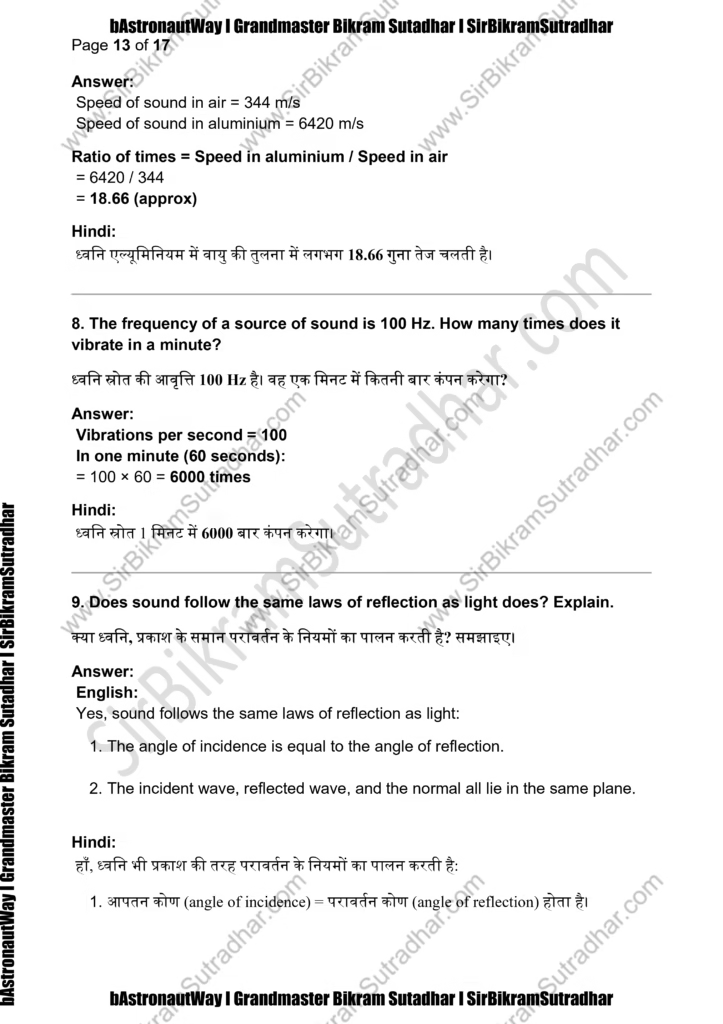
🔹 5. Sound Reflection / ध्वनि का परावर्तन
• When sound hits a surface and comes back, it is called reflection.
जब ध्वनि किसी सतह से टकराकर लौटती है, तो उसे परावर्तन कहते हैं।
🔁 Echo / प्रतिध्वनि: Sound heard after bouncing back with a gap of at least 0.1 second.
📏 Minimum distance for echo: 17.2 meters (at speed 343 m/s)

🔹 6. Hearing Range / श्रवण सीमा
• Human ears can perceive sound frequencies from 20 Hz to 20,000 Hz.
मनुष्य 20 हर्ट्ज़ से 20,000 हर्ट्ज़ तक की ध्वनि को सुन सकता है।
⚠️ < 20 Hz: Infrasonic (अवध्वनिक)
⚠️ > 20,000 Hz: Ultrasonic (पराश्रव्य)
🔹 7. Ultrasound & SONAR / पराश्रव्य तरंगें और सोनार
• Ultrasound is sound beyond the audible range (>20,000 Hz).
पराश्रव्य वे तरंगें हैं जिनकी आवृत्ति 20,000 हर्ट्ज़ से अधिक होती है।
• SONAR is a technique that sends out ultrasonic waves to detect underwater objects.
SONAR एक विधि है जो जल के नीचे वस्तुओं की जानकारी प्राप्त करने के लिए पराश्रव्य तरंगों का उपयोग करती है।
🛥 Applications / उपयोग: Submarines, sea exploration, fish finding
पनडुब्बियाँ, समुद्र विज्ञान, मछली ढूँढना
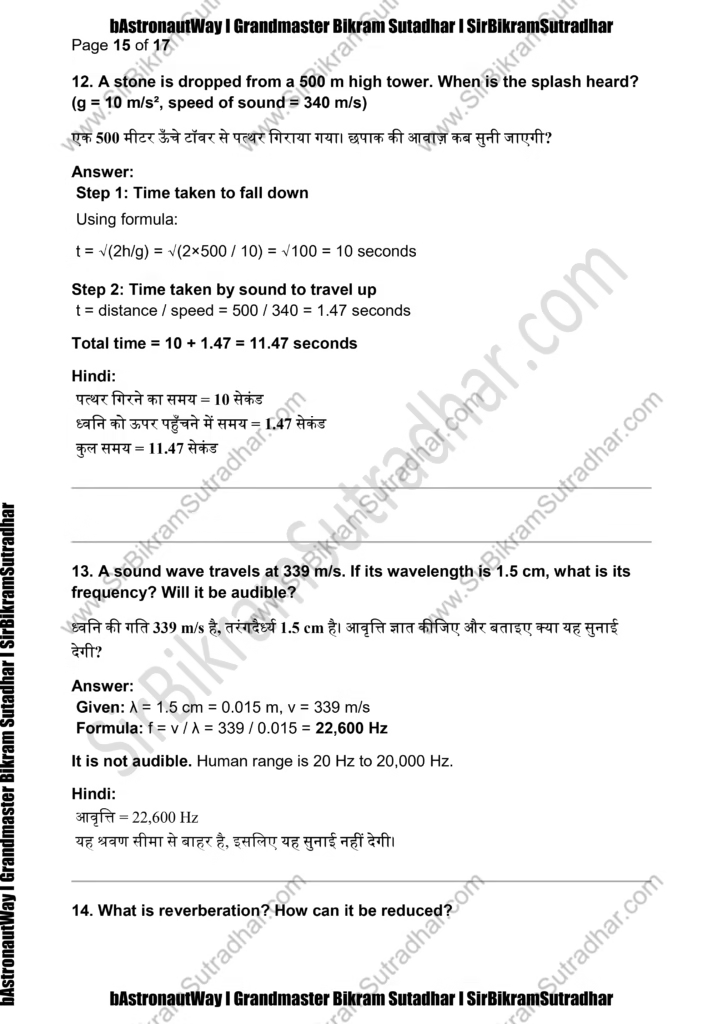
🔹 8. Structure of Human Ear / मानव कान की संरचना
👂 Process / प्रक्रिया:
- Outer ear collects sound →
- Sound moves via ear canal →
- Eardrum vibrates →
- Vibrations travel through middle ear →
- Inner ear converts them into electrical signals →
- Brain interprets them as sound
🧠 मस्तिष्क इन संकेतों को समझकर हमें ध्वनि का अनुभव कराता है।
✅ MCQs – Multiple Choice Questions (Paraphrased, Bilingual)
1️⃣ What is the unit for measuring frequency? / आवृत्ति मापने की इकाई क्या है?
🔘 (a) Joule 🔘 (b) Hertz 🔘 (c) Watt 🔘 (d) Decibel
✅ Answer: (b) Hertz / हर्ट्ज
2️⃣ Sound travels fastest in which of the following? / इनमें से किसमें ध्वनि सबसे तेज़ चलती है?
🔘 (a) Air 🔘 (b) Water 🔘 (c) Iron 🔘 (d) Space
✅ Answer: (c) Iron / लोहा
3️⃣ प्रतिध्वनि सुनने के लिए न्यूनतम दूरी क्या है?
🔘 (a) 10 m 🔘 (b) 17.2 m 🔘 (c) 5 m 🔘 (d) 2 m
✅ Answer: (b) 17.2 m / 17.2 मीटर
4️⃣ Which frequency represents ultrasonic sound? / कौन-सी आवृत्ति पराश्रव्य ध्वनि को दर्शाती है?
🔘 (a) 100 Hz 🔘 (b) 1000 Hz 🔘 (c) 20,000 Hz 🔘 (d) 40,000 Hz
✅ Answer: (d) 40,000 Hz / 40,000 हर्ट्ज
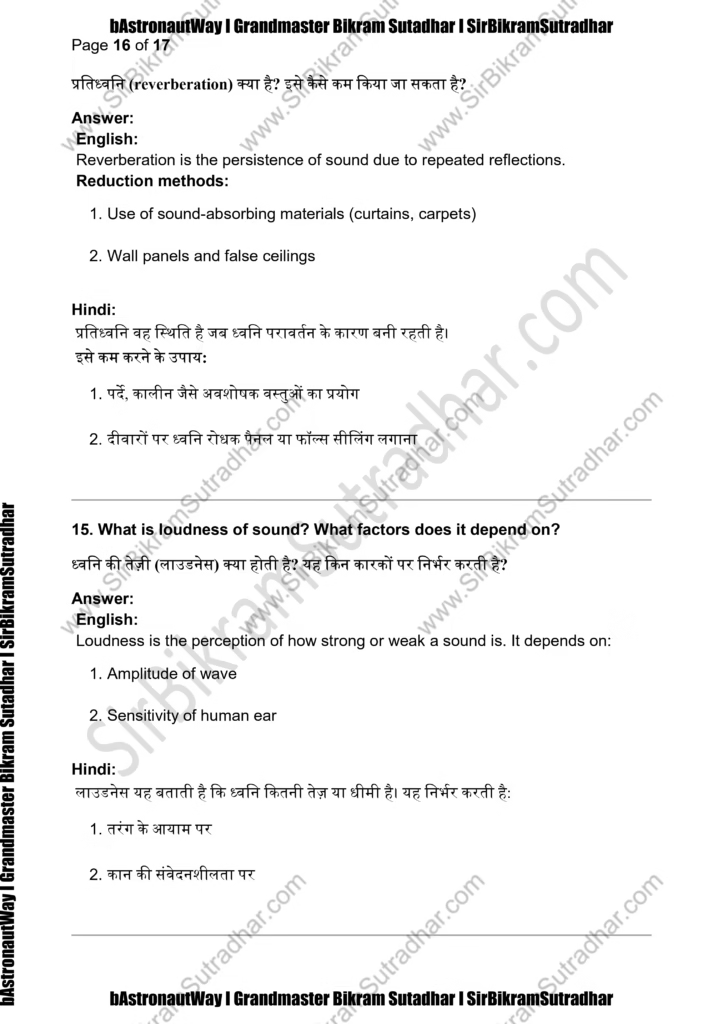
❓ FAQs – Frequently Asked Questions (Bilingual, Paraphrased)
🔹 Q1. Can sound exist in a vacuum? / क्या निर्वात में ध्वनि चल सकती है?
✅ No, it needs a medium to propagate.
✅ नहीं, ध्वनि को फैलने के लिए किसी माध्यम की आवश्यकता होती है।
🔹 Q2. What generates sound? / ध्वनि किससे उत्पन्न होती है?
✅ Sound is produced when objects vibrate.
✅ वस्तुओं के कंपन से ध्वनि उत्पन्न होती है।
🔹 Q3. What is the function of SONAR? / SONAR का कार्य क्या है?
✅ SONAR is used to find underwater objects using sound waves.
✅ सोनार का उपयोग जल के नीचे वस्तुओं का पता लगाने के लिए किया जाता है।
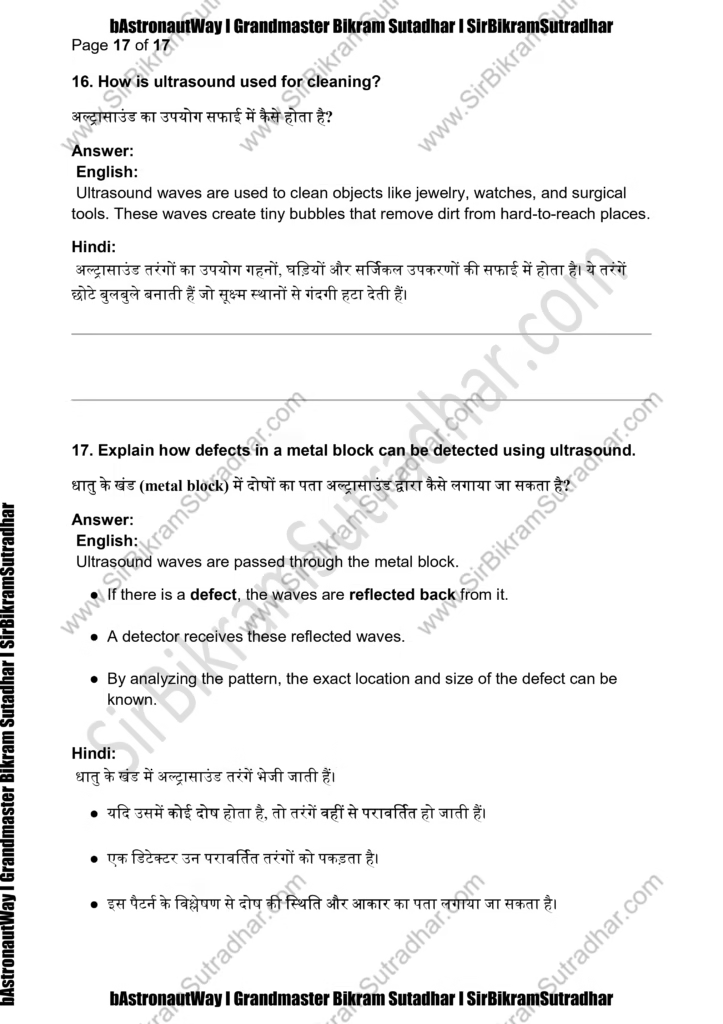

Written By
Full Stack Developer and 5-Time World Record Holder, Grandmaster Bikram Sutradhar
bAstronautWay
SirBikramSutradhar on YouTube
More Story click the link
ICSE CLASS 10 ICSE CLASS 10 BIOLOGY BASTRONAUTWAY SirBikramSutradhar Bikram Sutradhar GrandMaster Bikram Sutradhar selina biology solutions ICSE Biology Selina Solution
class 10 Maths ncert solution.
NCERT Solutions
CBSE Class 10 Mathematics (2025) NCERT Syllabus:
CBSE Class 10 Mathematics NCERT Syllabus (2025) – Chapter-Wise List
CBSE Class 10 Mathematics NCERT Syllabus (2025) – Chapter-Wise List
chapter 4. Quadratic Equations
chapter 5. Arithmetic Progressions
chapter 6. Triangles
chapter 7. Coordinate Geometry
chapter 8. Introduction to Trigonometry
chapter 9. Some Applications of Trigonometry
chapter 11. Areas Related to Circles
chapter 12. Surface Areas and Volumes
class 10 science ncert solution
CBSE Class 10 Science (2025) NCERT Syllabus:
CBSE Class 10 Science NCERT Syllabus (2025) – Chapter-Wise List
CBSE Class 10 Science NCERT Syllabus (2025) – Chapter-Wise List
Chapter 1 Chemical Reactions and Equations
Chapter 2 Acids, Bases and Salts
Chapter 3 Metals and Non-metals
Chapter 4 Carbon and its Compounds
Chapter 5 Life Processes
Chapter 6 Control and Coordination
Chapter 7 How do Organisms Reproduce?
Chapter 8 Heredity
Chapter 9 Light – Reflection and Refraction
Chapter 10 The Human Eye and the Colourful World
Chapter 11 Electricity
Chapter 12 Magnetic Effects of Electric Current
Chapter 13 Our Environment
📖 Chapter 12 – Organic Chemistry (Selina Textbook)
Table of Contents:
- 12A. Organic Compounds
- 12B. Hydrocarbons: Alkanes
- 12C. Hydrocarbons: Alkenes
- 12D. Hydrocarbons: Alkynes
- 12E. Alcohols
- 12F. Carboxylic Acids
- Exercise 12 MISCELLANEOUS
- Glossary
- Model Question Paper –
📌 Exercise 12 MISCELLANEOUS – Focus Areas:
🧬 Consolidated practice from the entire Organic Chemistry chapter
🧪 Application-based questions covering alkanes, alkenes, alkynes, alcohols, and carboxylic acids
🧾 Writing structural formulas and chemical equations
💡 Distinguishing reactions, isomer identification, and conversions
📘 Full-syllabus revision to boost conceptual clarity and board exam readiness
Each question in this section is designed to:
✅ Strengthen cross-topic understanding
📝 Prepare students for application-based and reasoning-based questions
🧠 Improve problem-solving speed and exam performance
























1 thought on “🧪 CBSE Class 9 Science Chapter 11 – Sound (ध्वनि) English & Hindi 📝 By Grandmaster Bikram Sutradhar (SirBikramSutradhar) | BASTRONAUTWAY”